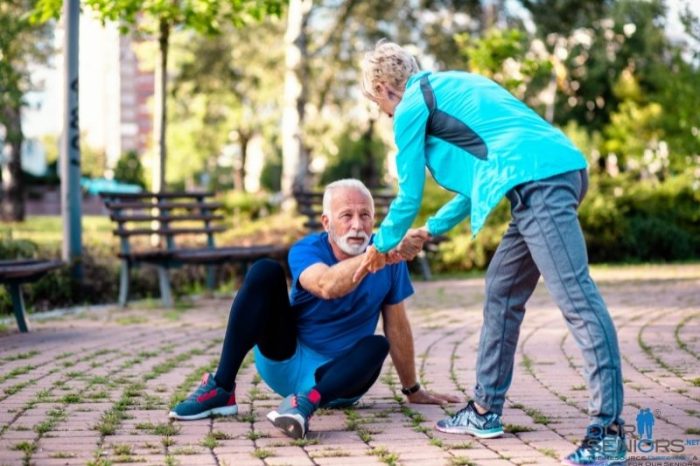Many senior concerns are imaginary or exaggerated, but fear of falling is not. Falling injuries often begin a downward cycle of health and wellbeing that leads to many other problems, even death. Ironically, the fear of falling may become as damaging as falling itself; this fear can lead to unnecessary limitations on the very activities that keep seniors mobile, fit and healthy.
According to the British Medical Journal, up to one half of all seniors have a range of problems related to the fear of falling. This is true regardless of whether or not they have a personal history of falls. They may have witnessed a fall, known someone who suffered an injury from falling or heard some grim story about the consequences of a fall. As a result, some seniors avoid activities that can actually help prevent these accidents. Anxieties about falling may lead to avoidance of healthy physical activity, increasing frailty and loss of balance. The fear of falling is both common and draining, but planning and thinking ahead can help to overcome this problem.
A good deal of effort is directed towards changing seniors’ environments in order to prevent falls. This is certainly important, but measures to maintain or increase a senior’s sense of balance and physical strength are just as vital. Probably more so, because these activities not only reduce fall risks, they also contribute to overall health, self-confidence and wellbeing. The changes seniors make to themselves may be more important in fall prevention than any modification to their surroundings.
It is not possible to totally eliminate falls through strength and balance training, but some simple exercises can go a long way. Think of the activities that can make you feel unsteady or unbalanced. Standing up from a sitting position, bending over, picking up objects on the ground and other common actions are all causes of falls. Simple exercises can reduce a senior’s exposure to these dangers. Of course, you should always talk to your doctor or physical therapist before starting new exercises.
Many of these exercises can be done safely at home. These “sit-to-stand” and basic balance-building exercises are helpful and require no special equipment.
The standing exercise involves sitting erect in a sturdy chair with some support surface (a table or desk) in front of you. Put your hands on your knees, lean forward and slowly rise to a standing position, trying not to use the support surface as an aid. If needed, put your hands on the support, but the goal is to do this without any help from your arms or hands. Sit down slowly and repeat this 5 to10 times. If you feel pain in the knees, back or hips, talk to your doctor before continuing.
When you think about it, rising or standing up is the start of all mobility, essential to normal life. This simple action, repeated faithfully, can keep you on the right side of the starting line. While there, try out this simple balance exercise.
- Position yourself near a sturdy table, or in a corner where you can reach out to the wall if you start to lose balance.
- Stand with your feet about shoulder-width apart and with your eyes open, as if you were walking.
- Hold this position for 10 seconds, working your way up to 30 seconds if your balance is steady.
If you need to reach out for support or start to lose balance after a few seconds, stop and rest. Keep working on this until you can maintain the position for a full 30 seconds. After you can dependably do this for the full 30 seconds, try it with your feet together. You may find this is a little more difficult, but the goal is to stand erect for 30 seconds without need for support.
Next, try to stand on one foot, eyes open, holding steady for 10 seconds and working up to 30 seconds. Repeat with the other foot. Do not be discouraged if you find that you do not have the ankle strength to do this at first. Keep working on it, and it will come.
Try to do five repetitions of these exercises twice a day. You may be surprised how quickly you can improve your performance on these balance-basics skills. You can see a video of a trained physical therapist doing these exercises at Johns Hopkins Medical Balance Exercise.
If you think you have any balance issues, please consult a physical therapist or doctor. Overcoming the fear of falling is vital to staying active and mobile. Today is a great time to be thinking about this subject, because right now, many of our senior centers are going through a “phased reopening.”
These centers offer programs like chair yoga, tai chi, safe exercise workouts and other activities that can help seniors to keep the sense of balance and physical strength needed throughout life. Falling should not be regarded as a natural part of aging. There are steps you can take to avoid it.
This article has concentrated on overcoming the fear of falling rather than falling itself. This fear may be as dangerous as any fall, because it can limit seniors (even those with no fall history) so sharply. Maintaining and using your mobility is critical to keeping good overall health and wellbeing. If you are finding yourself restricted by this anxiety, do not just accept it as a normal part of aging. Reach out to your doctor or physical therapist for advice.
Joining a group activity like chair yoga or tai chi can be a big help. You can start by doing a Google search for terms like “senior centers near me” or “senior yoga near me.” If your Medigap or Advantage insurance plan has a “Silver Sneakers” benefit, this may cover the cost of these programs. Here are some links to sites that may have helpful directions:
- Volusia County Council on Aging
- Volusia County Senior Centers
- Orange City Senior Center
- Daytona Beach Shores Center
- Ormond Beach Senior Center
- New Smyrna Beach Senior Center
- Lake County Senior Centers
- Seminole County Senior Centers
- Orange County Senior Centers

